Important Formula: Trigonometry | Mathematics for RRB NTPC / ASM - RRB NTPC/ASM/CA/TA PDF Download
Trigonometry formulas encompass various equations and identities involving trigonometric functions that aid in solving problems related to the sides and angles of right-angled triangles. These formulas, including trigonometric identities, are also utilized to simplify expressions, solve equations, and compute integrals effectively.
These formulas involve the primary trigonometric functions: sine, cosine, tangent, cosecant, secant, and cotangent, defined for specific angles. Key categories include Pythagorean identities, product-to-sum identities, co-function identities (angle transformations), sum and difference identities, double-angle identities, and half-angle identities. Each plays a crucial role in understanding and solving trigonometric problems, as explored in detail in the sections below.
What are Trigonometry Formulas?
Trigonometry formulas are mathematical relationships connecting the angles and sides of a right triangle. They serve as valuable tools in solving various problems involving angles, distances, and heights. Using these formulas, it is possible to determine unknown sides or angles in a right triangle.
Beyond fundamental formulas like the Pythagorean theorem, trigonometric identities and equations are extensively employed to simplify expressions, solve equations, and calculate integrals. These formulas are indispensable for professionals such as engineers, mathematicians, and scientists across diverse fields.
All Formulas of Trigonometry
Let’s explore the following sets of various trigonometric formulas.
- Basic Trig Ratio Formulas: formulas relating to the basic trigonometric ratios sin, cos, tan, etc.
- Reciprocal Identities: formulas dealing with the reciprocal relationship between trig ratios.
- Trigonometric Ratio Table: Trigonometry values are depicted for standard angles in the trigonometry table.
- Periodic Identities: trigonometry formulas that help in finding values of trig functions for a shift in angles by π/2, π, 2π, etc.
- Co-function Identities: formulas that depict interrelationships between the trigonometry functions.
- Sum and Difference Identities: formulas used to find the value of the trigonometry function for the sum or difference in angles.
- Half, Double and Triple Identities: formulas used to find the values of trig functions for half, double or triple angles.
- Sum to Product Identities: formulas used to represent the product of trigonometry functions as their sum or vice-versa.
- Inverse Trigonometry Formulas: formulas related to inverse trig functions like sine inverse, cosine inverse, etc.
- Sine Law and Cosine Law
Some basic trigonometry formulas can be observed in the image below. Let us study them in detail in the following sections.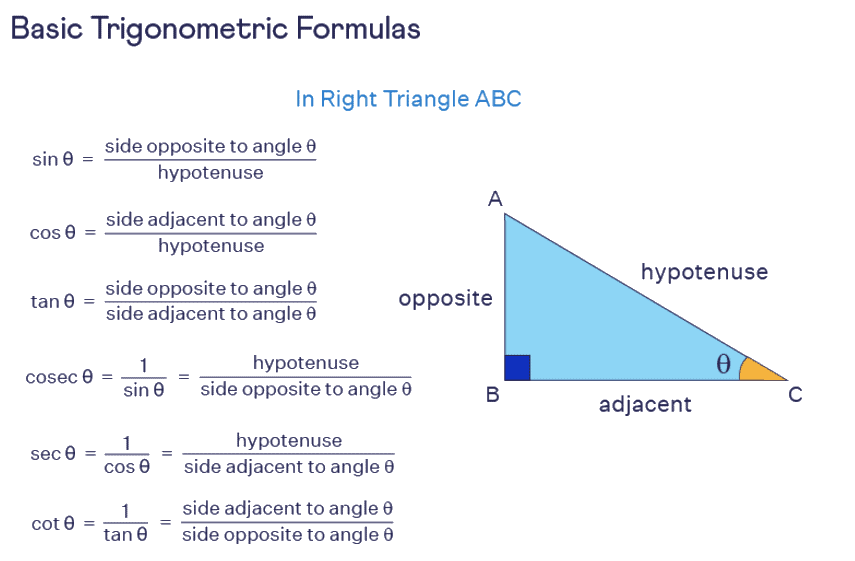
Basic Trigonometry Formulas
Basic trigonometry formulas establish the relationship between trigonometric ratios and the corresponding side ratios of a right-angled triangle. There are six fundamental trigonometric ratios, also known as trigonometric functions: sine, cosine, tangent, secant, cosecant, and cotangent, abbreviated as sin, cos, tan, sec, csc, and cot. These functions and identities are derived with a right-angled triangle as the basis. Using these formulas, the values of sine, cosine, tangent, secant, cosecant, and cotangent can be determined when the dimensions of a right-angled triangle are known.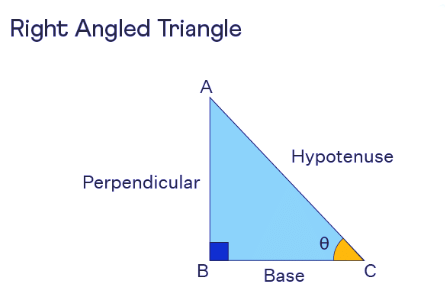
Trigonometric Ratio Formulas
- sin θ = Perpendicular/Hypotenuse
- cos θ = Base/Hypotenuse
- tan θ = Perpendicular/Base
- sec θ = Hypotenuse/Base
- cosec θ = Hypotenuse/Perpendicular
- cot θ = Base/Perpendicular
Reciprocal Identities
Cosecant, secant, and cotangent are the reciprocal functions of the primary trigonometric ratios sine, cosine, and tangent, respectively. These reciprocal identities are also based on a right-angled triangle as the reference and are derived from the fundamental trigonometric functions. The formulas for reciprocal identities, outlined below, are commonly used to simplify and solve trigonometric problems.
- cosec θ = 1/sin θ; sin θ = 1/cosec θ
- sec θ = 1/cos θ; cos θ = 1/sec θ
- cot θ = 1/tan θ; tan θ = 1/cot θ
Pythagorean Identities
Pythagoras theorem states that "in a right triangle, if 'c' is the hypotenuse and 'a' and 'b' are the two legs then c2 = a2 + b2". Using this theorem and trigonometric ratios, Pythagorean identities are derived. These identities are used to convert one trig ratio into other. The Pythagorean trig identities are mentioned below:
- sin2θ + cos2θ = 1
- sec2θ - tan2θ = 1
- csc2θ - cot2θ = 1
Trigonometric Ratio Table
Here is a table for trigonometry formulas for angles that are commonly used for solving trigonometry problems. The trigonometric ratios table helps in finding the values of trigonometric standard angles such as 0°, 30°, 45°, 60°, and 90°.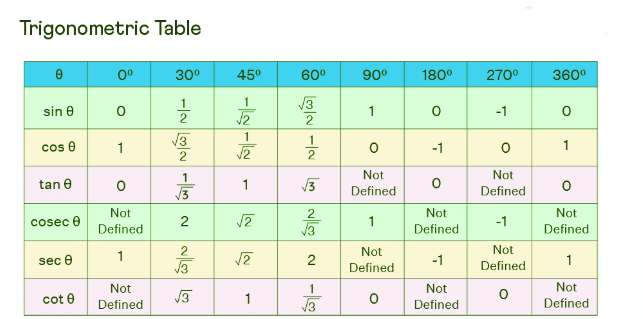
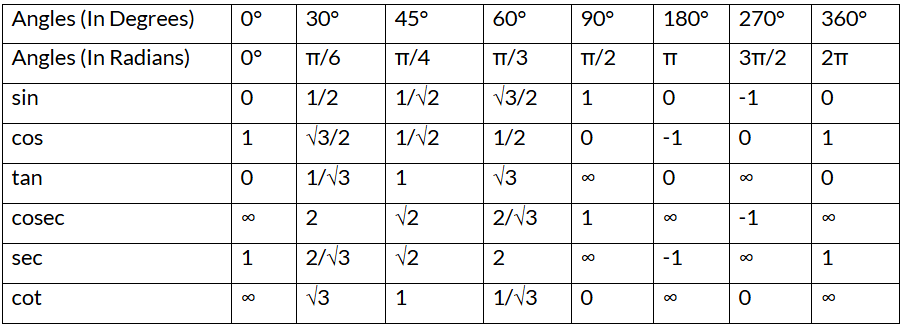
Unit Circle Formulas
The unit circle is a circle with a radius of 1 and center at the origin of a coordinate plane. It is used in trigonometry (as shown below) to define the values of trigonometric functions for all angles, including those outside the range of 0 to 90 degrees.
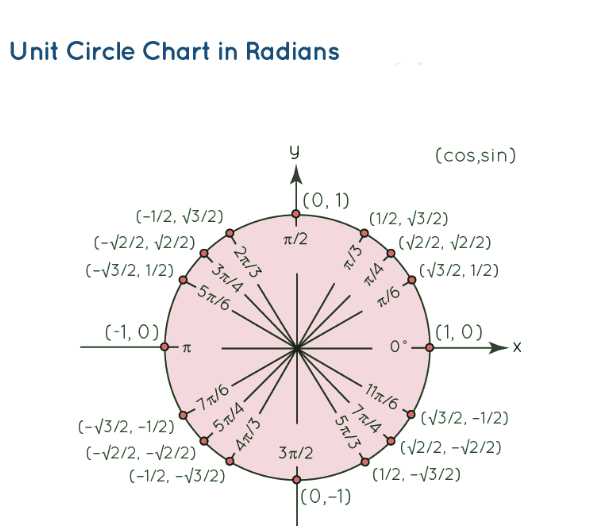
Here are some of the formulas associated with the unit circle:
- sin θ = y/1; csc θ = 1/y
- cos θ = x/1; sec θ = 1/x
- tan θ = sinθ/cosθ = y/x; cot θ = cosθ/sinθ = x/y
Trigonometry Periodic Identities (in Radians)
Trigonometry formulas involving periodic identities are used to shift the angles by π/2, π, 2π, etc. All trigonometric identities are cyclic in nature which means that they repeat themselves after a period. This period differs for different trigonometry formulas on periodic identities. For example, tan 30° = tan 210° but the same is not true for cos 30° and cos 210°. You can refer to the trigonometry formulas given below to verify the periodicity of sine and cosine functions in different quadrants.

First Quadrant:
- sin (π/2 – θ) = cos θ
- cos (π/2 – θ) = sin θ
- sin (2π + θ) = sin θ
- cos (2π + θ) = cos θ
Second Quadrant:
- sin (π/2 + θ) = cos θ
- cos (π/2 + θ) = – sin θ
- sin (π – θ) = sin θ
- cos (π – θ) = – cos θ
Third Quadrant:
- sin (π + θ) = – sin θ
- cos (π + θ) = – cos θ
- sin (3π/2 – θ) = – cos θ
- cos (3π/2 – θ) = – sin θ
Fourth Quadrant:
- sin (3π/2 + θ) = – cos θ
- cos (3π/2 + θ) = sin θ
- sin (2π – θ) = – sin θ
- cos (2π – θ) = cos θ
Co-function Identities(in Degrees)
The trigonometry formulas on cofunction identities provide the interrelationship between the different trigonometry functions. The co-function trigonometry formulas are represented in degrees below:
- sin(90° − x) = cos x
- cos(90° − x) = sin x
- tan(90° − x) = cot x
- cot(90° − x) = tan x
- sec(90° − x) = cosec x
- cosec(90° − x) = sec x
The cofunction identities in terms of radians can be obtained by replacing 90° with π/2 in the above formulas.
Sum and Difference Identities
The sum and difference identities include the trigonometry formulas of sin(x + y), cos(x - y), cot(x + y), etc.
- sin(x + y) = sin(x)cos(y) + cos(x)sin(y)
- cos(x + y) = cos(x)cos(y) - sin(x)sin(y)
- tan(x + y) = (tan x + tan y)/(1 - tan x • tan y)
- sin(x – y) = sin(x)cos(y) - cos(x)sin(y)
- cos(x – y) = cos(x)cos(y) + sin(x)sin(y)
- tan(x − y) = (tan x - tan y)/(1 + tan x • tan y)
Multiple and Sub-Multiple Angles
Trigonometry formulas for multiple and sub-multiple angles can be used to calculate the value of trigonometric functions for half angle, double angle, triple angle, etc.
Half-Angle Identities
The half angle trigonometric formulas involve x/2 and are as follows.
- sin (x/2) = ±√[(1 - cos x)/2]
- cos (x/2) = ± √[(1 + cos x)/2]
- tan (x/2) = ±√[(1 - cos x)/(1 + cos x)] (or) tan (x/2) = (1 - cos x)/sin x
Double Angle Identities
The double angle trigonometry formulas are used to find the double angle (2x) of trig functions.
- sin (2x) = 2sin(x) • cos(x) = [2tan x/(1 + tan2 x)]
- cos (2x) = cos2(x) - sin2(x) = [(1 - tan2 x)/(1 + tan2 x)] = 2cos2(x) - 1 = 1 - 2sin2(x)
- tan (2x) = [2tan(x)]/ [1 - tan2(x)]
- sec (2x) = sec2 x/(2 - sec2 x)
- cosec (2x) = (sec x • cosec x)/2
Triple Angle Identities
The trip angle (3x) trig formulas are as follows:
- sin 3x = 3sin x - 4sin3x
- cos 3x = 4cos3x - 3cos x
- tan 3x = [3tanx - tan3x]/[1 - 3tan2x]
Sum and Product Identities
Trigonometric formulas for sum or product identities are used to represent the sum of any two trigonometric functions in their product form, or vice-versa.
Product to Sum Formulas
- sinx⋅cosy = [sin(x + y) + sin(x − y)]/2
- cosx⋅cosy = [cos(x + y) + cos(x − y)]/2
- sinx⋅siny = [cos(x − y) − cos(x + y)]/2
Sum to Product Formulas
The combination of two acute angles A and B can be presented through the trigonometric ratios, in the below trigonometry formulas.
- sinx + siny = 2[sin((x + y)/2)cos((x − y)/2)]
- sinx − siny = 2[cos((x + y)/2)sin((x − y)/2)]
- cosx + cosy = 2[cos((x + y)/2)cos((x − y)/2)]
- cosx − cosy = −2[sin((x + y)/2)sin((x − y)/2)]
Inverse Trigonometry Formulas
Using the inverse trigonometry formulas, trigonometric ratios are inverted to create the inverse trigonometric functions, like, sin θ = x and θ = sin −1x. Here x can have values in whole numbers, decimals, fractions, and exponents.
- sin-1 (-x) = -sin-1 x
- cos-1 (-x) = π - cos-1 x
- tan-1 (-x) = -tan-1 x
- cosec-1 (-x) = -cosec-1 x
- sec-1 (-x) = π - sec-1 x
- cot-1 (-x) = π - cot-1 x
Sine and Cosine Laws
Sine Law: The sine law and the cosine law give a relationship between the sides and angles of a triangle. The sine law gives the ratio of the sides and the angle opposite to the side. As an example, the ratio is taken for the side 'a' and its opposite angle 'A'.
(sin A)/a = (sin B)/b = (sin C)/c
Cosine Law: The cosine law helps to find the length of a side, for the given lengths of the other two sides and the included angle. As an example the length 'a' can be found with the help of the other two sides 'b' and 'c' and their included angle 'A'.
- a2 = b2 + c2 - 2bc cosA
- b2 = a2 + c2 - 2ac cosB
- c2 = a2 + b2 - 2ab cosC
where, a, b, c are the lengths of the sides of the triangle, and A, B, C are the angles of the triangle.
|
146 videos|96 docs|98 tests
|
FAQs on Important Formula: Trigonometry - Mathematics for RRB NTPC / ASM - RRB NTPC/ASM/CA/TA
| 1. What are the basic trigonometric ratios? |  |
| 2. What are the reciprocal identities in trigonometry? |  |
| 3. How can I use the unit circle to find trigonometric values? |  |
| 4. What are the sum and difference identities for trigonometric functions? |  |
| 5. What are the half-angle identities in trigonometry? |  |

|
Explore Courses for RRB NTPC/ASM/CA/TA exam
|

|

















